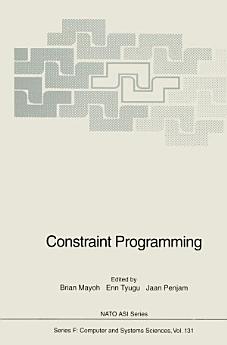Constraint Programming
Brian Mayoh · Enn Tyugu · Jaan Penjam
nov 2013 · Nato ASI Subseries F Libro 131 · Springer Science & Business Media
eBook
456
Páginas
reportLas valoraciones y las reseñas no se verifican. Más información
Información sobre este eBook
Constraint programming is like an octopus spreading its tentacles into databases, operations research, artificial intelligence, and many other areas. The concept of constraint programming was introduced in artificial intelligence and graphics in the 1960s and 1970s. Now the related techniques are used and studied in many fields of computing. Different aspects of constraint processing are investigated in theoretical computer science, logic programming, knowledge representation, operations research, and related application domains. Constraint programming has been included in the lists of related topics of many conferences. Nevertheless, only in 1993 were the first forums held, devoted as a whole to this field of knowledge. These were the First Workshop on Principles and Practice of Constraint Programming (PPCP'93) which was held in Newport, Rhode Island, USA, April 28-30, the International Workshop on Constraint Processing (at CSAM'93) held in St. Petersburg, Russia, July 20-21, and the NATO Advanced Study Institute (NATO AS!) on Constraint Programming held in Parnu, Estonia, August 13-24. NATO A Sis are aimed to be schools bringing together leading researchers and practitioners from industry and academia in some area of knowledge to provide a concise picture of the work done and results obtained by different groups. This is intended for dissemination of advanced knowledge not yet taught regularly in of new topics university. However, ASis must also encourage the introduction into university curricula as well as foster international scientific contacts.
Valorar este eBook
Danos tu opinión.
Información sobre cómo leer
Smartphones y tablets
Instala la aplicación Google Play Libros para Android y iPad/iPhone. Se sincroniza automáticamente con tu cuenta y te permite leer contenido online o sin conexión estés donde estés.
Ordenadores portátiles y de escritorio
Puedes usar el navegador web del ordenador para escuchar audiolibros que hayas comprado en Google Play.
eReaders y otros dispositivos
Para leer en dispositivos de tinta electrónica, como los lectores de libros electrónicos de Kobo, es necesario descargar un archivo y transferirlo al dispositivo. Sigue las instrucciones detalladas del Centro de Ayuda para transferir archivos a lectores de libros electrónicos compatibles.








